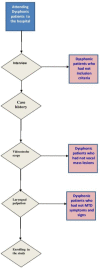Patient-Based Assessment of Effectiveness of Voice Therapy in Vocal Mass Lesions with Secondary Muscle Tension Dysphonia
- PMID: 29876327
- PMCID: PMC5985614
Patient-Based Assessment of Effectiveness of Voice Therapy in Vocal Mass Lesions with Secondary Muscle Tension Dysphonia
Abstract
Introduction: Use of patient-based voice assessment scales is an appropriate method that is frequently used to demonstrate effectiveness of voice therapy. This study was aimed at determining the effectiveness of voice therapy among patients with secondary muscle tension dysphonia (MTD) and vocal mass lesions.
Materials and methods: The study design was prospective, with within-participant repeated measures. Thirty-three patients with secondary MTD and vocal mass lesions participated in the study, selected on the basis of voice history, laryngeal palpation, and videostroboscopy examination. An experienced otolaryngologist and one experienced speech language pathologist undertook the diagnostic process. Voice therapy included both direct and indirect techniques and lasted approximately 2 months for all included patients. The voice handicap index (VHI) was used to evaluate the effectiveness of voice therapy among included patients. Paired t-test, size of the standardized effect (ESI), and mean standardized response (ESII) were used to analyze effectiveness of the target voice therapy.
Results: The findings of this study indicate a statistically significant improvement after the voice therapy protocol (P<0.05; t>1.96). Results of ESI and ESII demonstrate that the VHI scale is sufficiently responsive to detect voice therapy change (ES>0.8).
Conclusion: This study recommends a combination of direct and indirect voice therapy in the vocal rehabilitation of patients with secondary MTD and vocal mass lesions. Furthormore, we recommend use of the VHI scale to show voice therapy changes for both clinical and research purposes.
Keywords: Muscle tension dysphonia; Vocal mass lesions; Voice handicap index; Voice therapy.
Figures
Similar articles
-
Responsiveness of Persian Version of Consensus Auditory Perceptual Evaluation of Voice (CAPE-V), Persian Version of Voice Handicap Index (VHI), and Praat in Vocal Mass Lesions with Muscle Tension Dysphonia.J Voice. 2018 Nov;32(6):770.e21-770.e30. doi: 10.1016/j.jvoice.2017.08.008. Epub 2017 Oct 10. J Voice. 2018. PMID: 29029830
-
Vocal Function Exercises for Muscle Tension Dysphonia: Auditory-Perceptual Evaluation and Self-Assessment Rating.J Voice. 2017 Jul;31(4):506.e25-506.e31. doi: 10.1016/j.jvoice.2016.10.009. Epub 2016 Dec 16. J Voice. 2017. PMID: 27993500 Clinical Trial.
-
A Study of Vocal Facilitating Techniques Compared to Manual Circumlaryngeal Therapy in Teachers With Muscle Tension Dysphonia.J Voice. 2020 Nov;34(6):963.e11-963.e21. doi: 10.1016/j.jvoice.2019.06.002. Epub 2019 Jul 26. J Voice. 2020. PMID: 31353126 Clinical Trial.
-
Pathophysiology and treatment of muscle tension dysphonia: a review of the current knowledge.J Voice. 2011 Mar;25(2):202-7. doi: 10.1016/j.jvoice.2009.10.009. Epub 2010 Apr 18. J Voice. 2011. PMID: 20400263 Review.
-
Effects of Voice Therapy on Muscle Tension Dysphonia: A Systematic Literature Review.J Voice. 2018 Sep;32(5):546-552. doi: 10.1016/j.jvoice.2017.06.015. Epub 2017 Jul 22. J Voice. 2018. PMID: 28739332
Cited by
-
Psychometric Characteristics of Different Versions of Vocal Tract Discomfort (VTD) Scale: A Systematic Review.Iran J Public Health. 2022 Jan;51(1):37-47. doi: 10.18502/ijph.v51i1.8290. Iran J Public Health. 2022. PMID: 35223624 Free PMC article. Review.
-
Effects of Voice Therapy on Vocal Tract Discomfort in Muscle Tension Dysphonia.Iran J Otorhinolaryngol. 2019 Sep;31(106):297-304. Iran J Otorhinolaryngol. 2019. PMID: 31598497 Free PMC article.
References
-
- Dejonckere PH, Clemente P, Cornut G, Crevier Buchman L, Friedrich G, Van De Heyning, et al. A basic protocol for functional assessment of voice pathology, especially for investigating the efficacy of (phonosurgical) treatments and evaluating new assessment techniques. Eur Arch Otorhinolaryngol. 2001;258:77–82. - PubMed
-
- Kreiman J, Gerratt BR, Kempster G, Erman A, Berke G. Perceptual Evaluation of Voice Quality: Review, Tutorial, and a Framework for Future Research. J Speech Hear Res. 1993;36:31–2. - PubMed
-
- Helou LB, Solomon NP, Henry LR, Coppit GL, Howard RS, Stojadinovic A. The role of listener experience on Consensus Auditory-Perceptual Evaluation of Voice (CAPE-V) ratings of post-thyroidectomy voice. Am J Speech Lang Pathol. 2010;19:249–53. - PubMed
-
- Zraick RI, Kempster GB, Connor NP, Klaben BK, Bursac Z, Glaze LE. Establishing validity of the Consensus Auditory-Perceptual Evaluation of Voice (CAPE-V) Am J Speech Lang Pathol. 2011;20:16–17. - PubMed
-
- Karnell MP, Melton SD, Childes JM, Coleman TC, Dailey SA, Hoffman HT. documentation of voice disorders. J Voice. 2006;21:576–90. - PubMed
LinkOut - more resources
Full Text Sources

